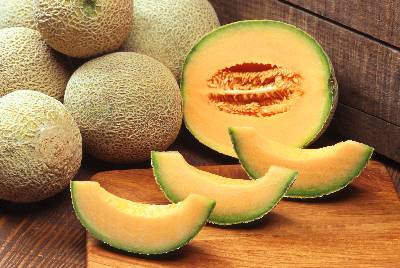Cantaloupe-Its Color Hints to its Good Nutrition
Fresh cantaloupe's orange color hints to its good nutrition. The orange color is due
to it containing beta-carotene, an orange pigment that also serves as a source of
vitamin A. Each one-cup serving of cantaloupe contains more vitamin A than the entire
daily recommended intake for adult women and men.
TEXARKANA, Ark. –

One of the advantages of summer is the fresh produce we have available. One of my favorites is cantaloupe. It has a green outer peel containing orange colored edible flesh inside it. It is a healthy fruit with low calories and a lot of vitamin content.
Fresh cantaloupe's orange color hints to its good nutrition. The orange color is due to it containing beta-carotene, an orange pigment that also serves as a source of vitamin A. Each one cup serving of cantaloupe contains more vitamin A than the entire daily recommended intake for adult women and men.
Vitamin A is beneficial in that it helps maintain healthy tissues, contributing to bone maintenance, functional retinas, skin cell growth and a strong immune system. Making cantaloupe a part of your regular diet helps to avoid the symptoms associated with vitamin A deficiency, including loss of vision and a weak immune system.
Eating fresh cantaloupe also boosts your intake of vitamin C, or ascorbic acid. This is important because vitamin C protects your cells from oxidative damage. Preventing this damage proves helpful in fighting against disease. It also helps your body make collagen, a protein essential to maintaining strong bones and skin.
While Vitamins A and C are the prominent vitamins in cantaloupe, you will also find other Vitamins like Vitamin B1, B2, B3, B5, B6, B9, E, K and minerals Calcium, Iron, Magnesium, Phosphorus, Potassium, and Zinc.
In order to purchase the best cantaloupe, use your nose as a guide to ripeness. Knowing how to select a ripe cantaloupe is about smell. It should smell like a cantaloupe. If ripe, it should have a distinctive fruity aroma where the fruit separates from the stem. If the characteristic aroma still isn’t present, the melon probably isn’t ready to be eaten.
There should not be a stem attached, instead, there should be a slight cavity at the end of the melon. The melon should have course netting on the rind with a light green, gray, buff or yellow coloring between the netting.
If the melon is overripe, you will see a softening of the entire rind and soft watery flesh. Small bruises will not usually hurt the flesh, but avoid those with large bruised areas since they generally cause soft, water-soaked areas underneath the rind.
Once purchased, store uncut cantaloupe at room temperature. Once cut, they should be kept in the refrigerator (or on ice in the case of a picnic, etc.) until consumed. Whole melons should be cleaned thoroughly with tap water before cutting and care should be taken to cut melons with clean utensils on clean surfaces.
Lucky for us, locally grown cantaloupe should be available throughout the summer at farmers markets and roadside stands. Even those purchased from the store are tasty this time of year. Just let your nose do the work for you and you should have a tasty treat for a hot summer day.
While fresh in a bowl is a my favorite, change it up and add sparkling water to fresh squeezed cantaloupe juice for a refreshing drink, or venture out and make cantaloupe soup, or make a fruit parfait alternating yogurt, cantaloupe, granola and topping with fresh mint. The options really are endless.
The University of Arkansas System Division of Agriculture, Miller County Extension office has information on healthy eating, come by the Miller County courthouse, e-mail me at chadley@uada.edu or call 870-779-3609. You can also get great tips on facebook at UAEXMillerCountyFCS/CarlaHaleyHadley, and twitter at @MillerCountyFCS or visiting our website at uaex.uada.edu/miller
By Carla Haley-Hadley
County Extension Agent - FCS
The Cooperative Extension Service
U of A System Division of Agriculture
Media Contact: Carla Haley-Hadley
County Extension Agent - FCS
U of A Division of Agriculture
Cooperative Extension Service
400 Laurel Street, Suite 215 Texarkana AR 71854
(870) 779-3609
chaley@uada.edu
The Arkansas Cooperative Extension Service is an equal opportunity institution. If
you require a reasonable accommodation to participate or need materials in another
format, please contact your County Extension office (or other appropriate office)
as soon as possible. Dial 711 for Arkansas Relay.
Pursuant to 7 CFR § 15.3, the University of Arkansas System Division of Agriculture
offers all its Extension and Research programs and services (including employment)
without regard to race, color, sex, national origin, religion, age, disability, marital
or veteran status, genetic information, sexual preference, pregnancy or any other
legally protected status, and is an equal opportunity institution.